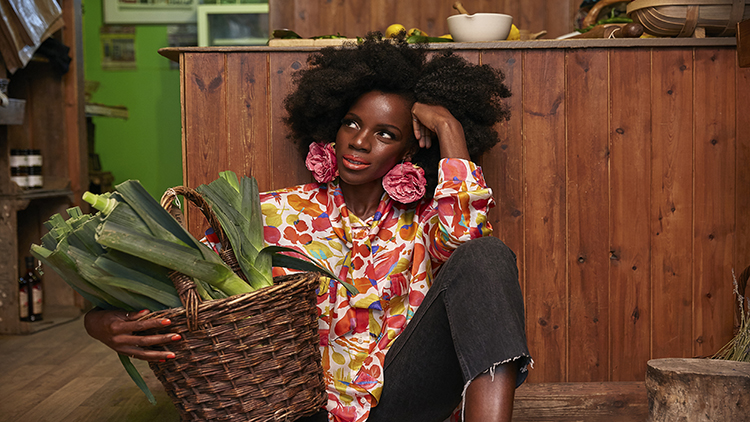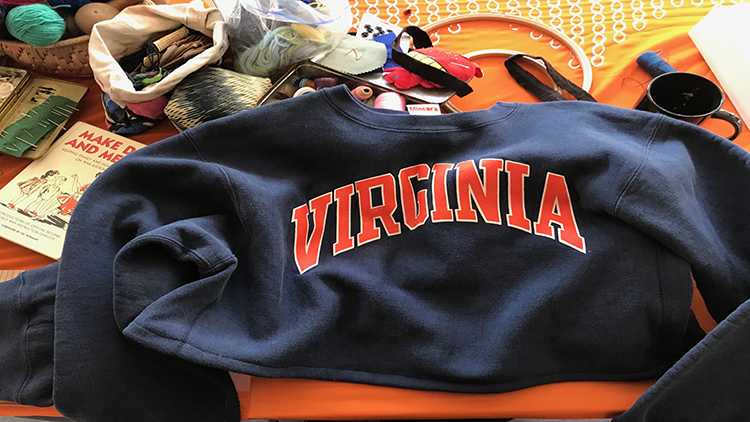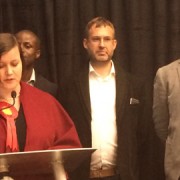
Food For Thought Seasonal Blouse, £195. Pic: Agata Kocon
The main concern with fast fashion is the large number of clothing which ends up in landfills. In 2016 over a million tonnes of clothing was purchased in the UK according to WRAP. Leigh Mcalea from TRAID said: “We are buying 38 million items of new clothes per week, while sending 11 million items to landfills per week.” Rather than relying on fast fashion, sustainable fashion brands, up-cycling initiatives and clothes swaps are just three ways to look stylish and help save the environment. Here are some alternatives to fast fashion:
Independent fashion brand Gung Ho launches new line
Instagram: @gung_ho_design
Instagram: @planthubuk
At the newly opened Hackney-based cafe called Plant Hub, Sophie Dunster is getting ready to launch her new collection. She is the founder and creative director of the independent fashion brand Gung Ho. Gung Ho revealed their new collection “Food For Thought,” which is inspired by important environmental topics such as food waste and eco-friendly clothing.
It’s Friday evening and Plant Hub has become packed with the area’s trendiest folks. Through a large window overlooking the kitchen there are about a dozen chefs feverishly preparing appetisers. At this event the chefs are also the models. They are known here as the “foodie wonder babes”. These ladies are “some of the most amazing and kick-ass women in the food industry not only preparing the delicious food but rocking the new collection too,” says Sophie. The kitchen goes dark as the “foodie wonder babes” emerge, modelling the new collection whilst serving vegan treats.
Gung Ho’s pricing starts at £35 with T-shirts, £120 with statement embroidered sweatshirts, blouses for £195 and jumpsuits at £325. The core collection is made locally in Stratford, out of fabrics sourced in Gloucestershire. “The fabrics we source are Tencel, a brand of regenerated eucalyptus fibre and a silk Tencel mix. It’s only about 32 per cent silk but it looks and feels like 100 per cent.”
Sophie said: “Gung Ho wants to inspire, change and spark conversation through clothing that doesn’t only make you look good but also allows you to wear your heart on your sleeve. Collaborating with pioneers in the industry such as Plant Hub makes logical sense as you get to taste the change too. Nobody needs to compromise on taste!”
Upcycling old clothes with Hackney Fixers
Instagram: @Worn_Well_UK
Instagram: @Lessismoresustainable1
The Hackney Fixers workshops take place across Hackney roughly once per month. This event is at the Hub 67 community centre in the heart of Hackney Wick. The event aims to encourage regular people to “upcycle” their old clothes into something new and fresh. Upcycling is a process through which old clothes are spruced up; by repairing holes adding new patches, buttons and designs. I brought an old Virginia College sweatshirt with me.

The Virginia University crop top Pic: Gregory Robinson
I show Sarah Klymkiw, who is running today’s clothing event, the old sweatshirt. I want to transform it into a crop top. Sarah explains that remaking and repairing clothes are great alternatives to shopping on the high street because it allows us to get the most out of what we already have. “We’re buying more but we’re not wearing more,” says Sarah. “By altering, adjusting and fixing the clothes that we are in our wardrobes benefits our bank balance, but from an environmental perspective, we’re reducing unnecessary waste and reducing our consumption of new resources with all the positive environmental changes it brings.”
Sarah introduces me to Silvia Barcellona, one of the “fixers” helping us to upcycle our old clothes. Silvia makes her own clothes, lives a vegan lifestyle and makes all her own cosmetic products which she posts on social media. The first step in transforming this sweatshirt is to trace, with chalk, the line to be cropped.
Most clothes repairs don’t need much more than a needle and thread so those averse to a sewing machine, or think it’s beyond their skill set, should not be put off. Sarah says: “The most common repairs are jeans that have worn through the crotch in need of patching. Its common among cyclists!”
We decide where the jumper will be cropped and secure the line with pins. Silvia leads me to one of the sewing machines, and once I sit down and become accustomed with the levers and the pedal all my memories from Year 9 came flooding back. Trying ever so carefully to remain straight, I sow along the line and within moments the top has been transformed! In between helping around half a dozen other people with their own fashion surgeries, Sara comes over and says: “Have you finished with your top? It looks amazing, well done!”
Instagram: @peashootfeasts
Pea Shoots normally organises plant-based feasts in Hackney however, this month they are hosting their very first clothes swap. It’s taking place at the Hackney Coffee Co. in Shoreditch. The brick walls inside, plant decorations and Frank Sinatra music playing from the speakers makes it the perfect location for a clothes swap, I presume, because this happens to be my first one.
People tend to bring a bag filled with their old clothes. Most of the clothing originally came from a high street shop. “Men bring lots of shirts!” explains Dora, from Pea Shoots. “People don’t tend to bring very valuable things, but everything is usually in very good condition. There are lots of really nice casual tops, dresses and loads of jeans.”
I chat to Gayathiri as she rummages through a pile of jumpers. “The clothes I usually end up bringing to clothes swaps are those I’ve swapped with friends before,” she says whilst trying on one of the jumpers. I normally bring clothes I don’t want any more or that I’m bored with.”
Her friend Anisha adds: “I wish I could go to more clothes swaps. You gain a lot of new clothing without having to spend money which lets you update your wardrobe.”
Finally, I meet Heeral and we discuss a bag she recently bought which was made out of saris. She happens to be friends with Gayathiri and Anisha and they have all swapped clothes with each other outside of clothes swaps. Heeral explains her boredom with high street shops, leading her to events like this one which, like myself, also happens to be her very first clothes swap experience.

Heeral, Anisha and Gayathiri at the Pea Shoot clothes swap Pic: Gregory Robinson
How would you encourage even more people to bring their clothes to clothes swaps?
“It’s all about knowledge.” Says Dora, “If people knew the full effect of fast-fashion on the environment, I am certain that more would want to bring their clothes to swaps. It would also help if clothes swaps were more frequent and visible to the public. Make them fun, focus on the excitement of finding an item of clothing that is unique, and remind people that a good piece of clothing can be worn for a whole lifetime.”
If you want to know more about how to live a zero-waste lifestyle, check out our Instagram page @ellnews, our Twitter @eastlondonlines and follow the hashtag #ELLzerowasteweek.




